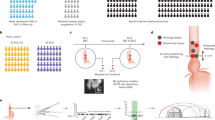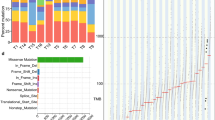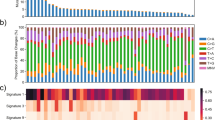Abstract
The incidence of Barrett’s esophagus (BE)-associated esophageal adenocarcinoma (EAC) is increasing. Next-generation sequencing (NGS) provides an unprecedented opportunity to uncover genomic alterations during BE pathogenesis and progression to EAC, but treatment-naive surgical specimens are scarce. The objective of this study was to establish the feasibility of using widely available endoscopic mucosal biopsies for successful NGS, using samples obtained from a BE ‘progressor’. Paired-end whole-genome NGS was performed on the Illumina platform using libraries generated from mucosal biopsies of normal squamous epithelium (NSE), BE and EAC obtained from a patient who progressed to adenocarcinoma during endoscopic surveillance. Selective validation studies, including Sanger sequencing, immunohistochemistry and functional assays, were performed to confirm the NGS findings. NGS identified somatic nonsense mutations of AT-rich interactive domain 1A (SWI like) (ARID1A) and PPIE and an additional 37 missense mutations in BE and/or EAC, which were confirmed by Sanger sequencing. ARID1A mutations were detected in 15% (3/20) high-grade dysplasia (HGD)/EAC patients. Immunohistochemistry performed on an independent archival cohort demonstrated ARID1A protein loss in 0% (0/76), 4.9% (2/40), 14.3% (4/28), 16.0% (8/50) and 12.2% (12/98) of NSE, BE, low-grade dysplasia, HGD and EAC tissues, respectively, and was inversely associated with nuclear p53 accumulation (P=0.028). Enhanced cell growth, proliferation and invasion were observed on ARID1A knockdown in EAC cells. In addition, genes downstream of ARID1A that potentially contribute to the ARID1A knockdown phenotype were identified. Our studies establish the feasibility of using mucosal biopsies for NGS, which should enable the comparative analysis of larger ‘progressor’ versus ‘non-progressor’ cohorts. Further, we identify ARID1A as a novel tumor-suppressor gene in BE pathogenesis, reiterating the importance of aberrant chromatin in the metaplasia–dysplasia sequence.
This is a preview of subscription content, access via your institution
Access options
Subscribe to this journal
Receive 50 print issues and online access
$259.00 per year
only $5.18 per issue
Buy this article
- Purchase on Springer Link
- Instant access to full article PDF
Prices may be subject to local taxes which are calculated during checkout





Similar content being viewed by others
Accession codes
References
Siegel R, Naishadham D, Jemal A . Cancer statistics, 2012. CA Cancer J Clin 2012; 62: 10–29.
Reid BJ, Li X, Galipeau PC, Vaughan TL . Barrett’s oesophagus and oesophageal adenocarcinoma: time for a new synthesis. Nat Rev Cancer 2010; 10: 87–101.
Gilbert EW, Luna RA, Harrison VL, Hunter JG . Barrett’s esophagus: a review of the literature. J Gastrointestinal Surg 2011; 15: 708–718.
Hvid-Jensen F, Pedersen L, Drewes AM, Sorensen HT, Funch-Jensen P . Incidence of adenocarcinoma among patients with Barrett’s esophagus. N Engl J Med 2011; 365: 1375–1383.
Yousef F, Cardwell C, Cantwell MM, Galway K, Johnston BT, Murray L . The incidence of esophageal cancer and high-grade dysplasia in Barrett’s esophagus: a systematic review and meta-analysis. Am J Epidemiol 2008; 168: 237–249.
Hanahan D, Weinberg RA . Hallmarks of cancer: the next generation. Cell 2011; 144: 646–674.
Vogelstein B, Kinzler KW . Cancer genes and the pathways they control. Nat Med 2004; 10: 789–799.
Sato F, Meltzer SJ . CpG island hypermethylation in progression of esophageal and gastric cancer. Cancer 2006; 106: 483–493.
Jin Z, Cheng Y, Gu W, Zheng Y, Sato F, Mori Y et al. A multicenter, double-blinded validation study of methylation biomarkers for progression prediction in Barrett's esophagus. Cancer Res 2009; 69: 4112–4115.
Alvarez H, Opalinska J, Zhou L, Sohal D, Fazzari MJ, Yu Y et al. Widespread hypomethylation occurs early and synergizes with gene amplification during esophageal carcinogenesis. Plos Genet 2011; 7: e1001356.
Paulson TG, Maley CC, Li X, Li H, Sanchez CA, Chao DL et al. Chromosomal instability and copy number alterations in Barrett's esophagus and esophageal adenocarcinoma. Clin Cancer Res 2009; 15: 3305–3314.
Li X, Galipeau PC, Sanchez CA, Blount PL, Maley CC, Arnaudo J et al. Single nucleotide polymorphism-based genome-wide chromosome copy change, loss of heterozygosity, and aneuploidy in Barrett’s esophagus neoplastic progression. Cancer Prev Res 2008; 1: 413–423.
di Pietro M, Lao-Sirieix P, Boyle S, Cassidy A, Castillo D, Saadi A et al. Evidence for a functional role of epigenetically regulated midcluster HOXB genes in the development of Barrett esophagus. Proc Nat Acad Sci USA 2012; 109: 9077–9082.
Goh XY, Rees JR, Paterson AL, Chin SF, Marioni JC, Save V et al. Integrative analysis of array-comparative genomic hybridisation and matched gene expression profiling data reveals novel genes with prognostic significance in oesophageal adenocarcinoma. Gut 2011; 60: 1317–1326.
Kaz AM, Grady WM . Epigenetic biomarkers in esophageal cancer. Cancer Lett (e-pub ahead of print 7 March 2012).
Paulson TG, Galipeau PC, Xu L, Kissel HD, Li X, Blount PL et al. p16 mutation spectrum in the premalignant condition Barrett’s esophagus. PloS ONE 2008; 3: e3809.
Galipeau PC, Li X, Blount PL, Maley CC, Sanchez CA, Odze RD et al. NSAIDs modulate CDKN2A, TP53, and DNA content risk for progression to esophageal adenocarcinoma. PloS Med 2007; 4: e67.
Reid BJ . p53 and neoplastic progression in Barrett’s esophagus. Am J Gastroenterol 2001; 96: 1321–1323.
Wood LD, Parsons DW, Jones S, Lin J, Sjoblom T, Leary RJ et al. The genomic landscapes of human breast and colorectal cancers. Science 2007; 318: 1108–1113.
Jones S, Wang TL, Shih IeM, Mao TL, Nakayama K, Roden R et al. Frequent mutations of chromatin remodeling gene ARID1A in ovarian clear cell carcinoma. Science 2010; 330: 228–231.
Nik-Zainal S, Alexandrov LB, Wedge DC, Van Loo P, Greenman CD, Raine K et al. Mutational processes molding the genomes of 21 breast cancers. Cell 2012; 149: 979–993.
Link DC, Schuettpelz LG, Shen D, Wang JL, Walter MJ, Kulkarni S et al. Identification of a novel TP53 cancer susceptibility mutation through whole-genome sequencing of a patient with therapy-related AML. JAMA 2011; 305: 1568–1576.
Clark MJ, Homer N, O’Connor BD, Chen Z, Eskin A, Lee H et al. U87MG decoded: the genomic sequence of a cytogenetically aberrant human cancer cell line. PloS Genet 2010; 6: e1000832.
Kumar A, White TA, MacKenzie AP, Clegg N, Lee C, Dumpit RF et al. Exome sequencing identifies a spectrum of mutation frequencies in advanced and lethal prostate cancers. Proc Nat Acad Sci USA 2011; 108: 17087–17092.
Wu J, Matthaei H, Maitra A, Dal Molin M, Wood LD, Eshleman JR et al. Recurrent GNAS mutations define an unexpected pathway for pancreatic cyst development. Sci Translational Med 2011; 3: 92ra66.
Wang KK, Wongkeesong M, Buttar NS . American Gastroenterological Association medical position statement: role of the gastroenterologist in the management of esophageal carcinoma. Gastroenterology 2005; 128: 1468–1470.
van Hagen P, Hulshof MC, van Lanschot JJ, Steyerberg EW, van Berge Henegouwen MI, Wijnhoven BP et al. Preoperative chemoradiotherapy for esophageal or junctional cancer. N Engl J Med 2012; 366: 2074–2084.
Alvarez H, Montgomery EA, Karikari C, Canto M, Dunbar KB, Wang JS et al. The Axl receptor tyrosine kinase is an adverse prognostic factor and a therapeutic target in esophageal adenocarcinoma. Cancer Biol Ther 2010; 10: 1009–1018.
Huang J, Zhao YL, Li Y, Fletcher JA, Xiao S . Genomic and functional evidence for an ARID1A tumor suppressor role. Genes Chromosomes Cancer 2007; 46: 745–750.
Mardis ER, Ding L, Dooling DJ, Larson DE, McLellan MD, Chen K et al. Recurring mutations found by sequencing an acute myeloid leukemia genome. New Engl J Med 2009; 361: 1058–1066.
Li M, Zhao H, Zhang X, Wood LD, Anders RA, Choti MA et al. Inactivating mutations of the chromatin remodeling gene ARID2 in hepatocellular carcinoma. Nat Genet 2011; 43: 828–829.
Wang K, Kan J, Yuen ST, Shi ST, Chu KM, Law S et al. Exome sequencing identifies frequent mutation of ARID1A in molecular subtypes of gastric cancer. Nat Genet 2011; 43: 1219–1223.
Wang S, Zhan M, Yin J, Abraham JM, Mori Y, Sato F et al. Transcriptional profiling suggests that Barrett’s metaplasia is an early intermediate stage in esophageal adenocarcinogenesis. Oncogene 2006; 25: 3346–3356.
Ashworth A, Lord CJ, Reis-Filho JS . Genetic interactions in cancer progression and treatment. Cell 2011; 145: 30–38.
Reya T, Morrison SJ, Clarke MF, Weissman IL . Stem cells, cancer, and cancer stem cells. Nature 2001; 414: 105–111.
Yates LR, Campbell PJ . Evolution of the cancer genome. Nat Rev Genet 2012; 13: 795–806.
Nik-Zainal S, Van Loo P, Wedge DC, Alexandrov LB, Greenman CD, Lau KW et al. The life history of 21 breast cancers. Cell 2012; 149: 5.
Jones S, Li M, Parsons DW, Zhang X, Wesseling J, Kristel P et al. Somatic mutations in the chromatin remodeling gene ARID1A occur in several tumor types. Hum Mutat 2012; 33: 100–103.
Wiegand KC, Shah SP, Al-Agha OM, Zhao Y, Tse K, Zeng T et al. ARID1A mutations in endometriosis-associated ovarian carcinomas. N Engl J Med 2010; 363: 1532–1543.
Agrawal N, Jiao Y, Bettegowda C, Hutfless SM, Wang Y, David S et al. Comparative genomic analysis of esophageal adenocarcinoma and squamous cell carcinoma. Cancer Discovery 2012; 2: 899–905.
Zang ZJ, Cutcutache I, Poon SL, Zhang SL, McPherson JR, Tao J et al. Exome sequencing of gastric adenocarcinoma identifies recurrent somatic mutations in cell adhesion and chromatin remodeling genes. Nat Genet 2012; 44: 570–574.
Luby TM . Targeting cytochrome P450 CYP1B1 with a therapeutic cancer vaccine. Expert Rev Vaccines 2008; 7: 995–1003.
McFadyen MC, Melvin WT, Murray GI . Cytochrome P450 enzymes: novel options for cancer therapeutics. Mol Cancer Ther 2004; 3: 363–371.
Martinez VG, O’Connor R, Liang Y, Clynes M . CYP1B1 expression is induced by docetaxel: effect on cell viability and drug resistance. Br J Cancer 2008; 98: 564–570.
Mishra SK, Siddique HR, Saleem M . S100A4 calcium-binding protein is key player in tumor progression and metastasis: preclinical and clinical evidence. Cancer Metastasis Rev 2011; 31: 163–172.
Sherbet GV, Lakshmi MS . S100A4 (MTS1) calcium binding protein in cancer growth, invasion and metastasis. Anticancer Res 1998; 18: 2415–2421.
Lee OJ, Hong SM, Belkhiri A, Moskaluk C, El-Rifai W . Overexpression of calcium binding protein S100A4 in Barrett’s tumorigenesis. Gastroenterology 2006; 130: A273–A273.
Berinstein NL . Carcinoembryonic antigen as a target for therapeutic anticancer vaccines: a review. J Clin Oncol 2002; 20: 2197–2207.
Griffin M, Sweeney EC . The relationship of endocrine cells, dysplasia and carcinoembryonic antigen in Barrett's mucosa to adenocarcinoma of the oesophagus. Histopathology 1987; 11: 53–62.
Ordonez C, Screaton RA, Ilantzis C, Stanners CP . Human carcinoembryonic antigen functions as a general inhibitor of anoikis. Cancer Res 2000; 60: 3419–3424.
Camacho-Leal P, Stanners CP . The human carcinoembryonic antigen (CEA) GPI anchor mediates anoikis inhibition by inactivation of the intrinsic death pathway. Oncogene 2008; 27: 1545–1553.
Fair K, Anderson M, Bulanova E, Mi H, Tropschug M, Diaz MO . Protein interactions of the MLL PHD fingers modulate MLL target gene regulation in human cells. Mol Cell Biol 2001; 21: 3589–3597.
Wang Z, Song J, Milne TA, Wang GG, Li H, Allis CD et al. Pro isomerization in MLL1 PHD3-bromo cassette connects H3K4me readout to CyP33 and HDAC-mediated repression. Cell 2010; 141: 1183–1194.
Park S, Osmers U, Raman G, Schwantes RH, Diaz MO, Bushweller JH . The PHD3 domain of MLL acts as a CYP33-regulated switch between MLL-mediated activation and repression. Biochemistry-US 2010; 49: 6576–6586.
Li H, Handsaker B, Wysoker A, Fennell T, Ruan J, Homer N et al. The sequence alignment/map format and SAMtools. Bioinformatics 2009; 25: 2078–2079.
McKenna A, Hanna M, Banks E, Sivachenko A, Cibulskis K, Kernytsky A et al. The genome analysis toolkit: a MapReduce framework for analyzing next-generation DNA sequencing data. Genome Res 2010; 20: 1297–1303.
DePristo MA, Banks E, Poplin R, Garimella KV, Maguire JR, Hartl C et al. A framework for variation discovery and genotyping using next-generation DNA sequencing data. Nat Genet 2011; 43: 491–498.
Rozen S, Skaletsky H . Primer3 on the WWW for general users and for biologist programmers. Methods Mol Biol 2000; 132: 365–386.
Streppel MM, Vincent A, Mukherjee R, Campbell NR, Chen SH, Konstantopoulos K et al. Mucin 16 (cancer antigen 125) expression in human tissues and cell lines and correlation with clinical outcome in adenocarcinomas of the pancreas, esophagus, stomach, and colon. Hum Pathol 2012; 43: 1755–1763.
Alvarez H, Koorstra JB, Hong SM, Boonstra JJ, Dinjens WN, Foratiere AA et al. Establishment and characterization of a bona fide Barrett esophagus-associated adenocarcinoma cell line. Cancer Biol Ther 2008; 7: 1753–1755.
Gupta S, Pramanik D, Mukherjee R, Campbell NR, Elumalai S, de Wilde RF et al. Molecular determinants of retinoic acid sensitivity in pancreatic cancer. Clin Cancer Res 2012; 18: 280–289.
Schmittgen TD, Livak KJ . Analyzing real-time PCR data by the comparative C(T) method. Nat Protoc 2008; 3: 1101–1108.
Cornen S, Adelaide J, Bertucci F, Finetti P, Guille A, Birnbaum DJ et al. Mutations and deletions of ARID1A in breast tumors. Oncogene 2012; 31: 4255–4256.
Mamo A, Cavallone L, Tuzmen S, Chabot C, Ferrario C, Hassan S et al. An integrated genomic approach identifies ARID1A as a candidate tumor-suppressor gene in breast cancer. Oncogene 2012; 31: 2090–2100.
Fujimoto A, Totoki Y, Abe T, Boroevich KA, Hosoda F, Nguyen HH et al. Whole-genome sequencing of liver cancers identifies etiological influences on mutation patterns and recurrent mutations in chromatin regulators. Nat Genet 2012; 44: 760–764.
Birnbaum DJ, Adelaide J, Mamessier E, Finetti P, Lagarde A, Monges G et al. Genome profiling of pancreatic adenocarcinoma. Genes Chromosomes Cancer 2011; 50: 456–465.
Gui Y, Guo G, Huang Y, Hu X, Tang A, Gao S et al. Frequent mutations of chromatin remodeling genes in transitional cell carcinoma of the bladder. Nat Genet 2011; 43: 875–878.
Acknowledgements
The work at Johns Hopkins Medical Institutions was funded by the Jerry D’Amato foundation and the NIH (1K23DK068149) and the work at WRM’s laboratory was supported by a Cancer Center Support Grant (CA045508) from the NCI and NIH Shared Instrument grant S10 RR023702-01. MMS has been sponsored by Fulbright/the Netherland America Foundation and the René Vogels Foundation.
The patient’s consent was obtained under an IRB-approved protocol.
Author contributions: MMS acquired, analyzed the data, performed statistical analysis and drafted the manuscript. SL performed the bioinformatics analysis. SL, MD, AMM, SP and EA acquired, analyzed and interpreted data, and critically revised the manuscript. JSW, MIC, FHMM and GJO provided materials and critically revised the manuscript. EAM, WRM and AM interpreted data, critically revised the manuscript, obtained funding and supervised the study. We would like to sincerely thank Conover Talbot Jr from the Institute for Basic Biomedical Sciences at Johns Hopkins School of Medicine for his help with the bioinformatics analysis of the Affymetrix Gene Expression Array data.
Author information
Authors and Affiliations
Corresponding authors
Ethics declarations
Competing interests
WRM has participated in Illumina sponsored meetings over the past 4 years and received travel reimbursement and honoraria for presenting at these events. The remaining authors declare no conflict of interest.
Additional information
Supplementary Information accompanies the paper on the Oncogene website
Supplementary information
Rights and permissions
About this article
Cite this article
Streppel, M., Lata, S., DelaBastide, M. et al. Next-generation sequencing of endoscopic biopsies identifies ARID1A as a tumor-suppressor gene in Barrett’s esophagus. Oncogene 33, 347–357 (2014). https://doi.org/10.1038/onc.2012.586
Received:
Revised:
Accepted:
Published:
Issue Date:
DOI: https://doi.org/10.1038/onc.2012.586
Keywords
This article is cited by
-
Genetic profiles of Barrett’s esophagus and esophageal adenocarcinoma in Japanese patients
Scientific Reports (2021)
-
Comprehensive Analysis of Barrett’s Esophagus: Focused on Carcinogenic Potential for Barrett’s Cancer in Japanese Patients
Digestive Diseases and Sciences (2021)
-
Loss of the SWI/SNF-ATPase subunit members SMARCF1 (ARID1A), SMARCA2 (BRM), SMARCA4 (BRG1) and SMARCB1 (INI1) in oesophageal adenocarcinoma
BMC Cancer (2020)
-
Targeting AURKA-CDC25C axis to induce synthetic lethality in ARID1A-deficient colorectal cancer cells
Nature Communications (2018)
-
Molecular Evolution of Metaplasia to Adenocarcinoma in the Esophagus
Digestive Diseases and Sciences (2018)



